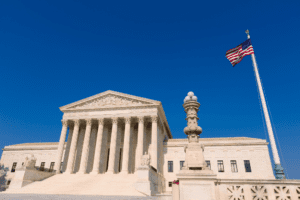 The dissent continued: Other States and Territories adopted similar laws. See, e.g., 1875 Wyo. Terr. Sess. Laws ch. 52, §1; 1889 Idaho Terr. Gen. Laws §1, p. 23; 1881 Kan. Sess. Laws §23, p. 92; 1889 Ariz. Terr. Sess. Laws no. 13, §1, p. 16. When they were challenged, these laws were generally upheld. P. Charles, The Faces of the Second Amendment Outside the Home, Take Two: How We Got Here and Why It Matters, 64 Clev. St. L. Rev. 373, 414 (2016); see also ante, at 56–57 (majority opinion) (recognizing that postbellum Texas law and court decisions support the validity of New York’s licensing regime); Andrews, 50 Tenn., at 182 (recognizing that “a man may well be prohibited from carrying his arms to church, or other public assemblage,” and that the carriage of arms other than rifles, shot guns, muskets, and repeaters “may be prohibited if the Legislature deems proper, absolutely, at all times, and under all circumstances”).
The dissent continued: Other States and Territories adopted similar laws. See, e.g., 1875 Wyo. Terr. Sess. Laws ch. 52, §1; 1889 Idaho Terr. Gen. Laws §1, p. 23; 1881 Kan. Sess. Laws §23, p. 92; 1889 Ariz. Terr. Sess. Laws no. 13, §1, p. 16. When they were challenged, these laws were generally upheld. P. Charles, The Faces of the Second Amendment Outside the Home, Take Two: How We Got Here and Why It Matters, 64 Clev. St. L. Rev. 373, 414 (2016); see also ante, at 56–57 (majority opinion) (recognizing that postbellum Texas law and court decisions support the validity of New York’s licensing regime); Andrews, 50 Tenn., at 182 (recognizing that “a man may well be prohibited from carrying his arms to church, or other public assemblage,” and that the carriage of arms other than rifles, shot guns, muskets, and repeaters “may be prohibited if the Legislature deems proper, absolutely, at all times, and under all circumstances”).
The Court’s principal answer to these broad prohibitions on public carriage is to discount gun control laws passed in the American West. Ante, at 58–61. It notes that laws enacted in the Western Territories were “rarely subject to judicial scrutiny.” Ante, at 60. But, of course, that may well mean that “we . . . can assume it settled that these” regulations were “consistent with the Second Amendment.” See ante, at 21 (majority opinion). The Court also reasons that laws enacted in the Western Territories applied to a relatively small portion of the population and were comparatively short lived. See ante, 59–61. But even assuming that is true, it does not mean that these laws were historical aberrations. To the contrary, bans on public carriage in the American West and elsewhere constitute just one chapter of the centuries-old tradition of comparable firearms regulations described above.
The Court disregards “20th-century historical evidence.” Ante, at 58, n. 28. But it is worth noting that the law the Court strikes down today is well over 100 years old, having been enacted in 1911 and amended to substantially its present form in 1913. See supra, at 12. That alone gives it a longer historical pedigree than at least three of the four types of firearms regulations that Heller identified as “presumptively lawful.” 554 U. S., at 626–627, and n. 26; see C. Larson, Four Exceptions in Search of a Theory: District of Columbia v. Heller and Judicial Ipse Dixit, 60 Hastings L. J. 1371, 1374–1379 (2009) (concluding that “‘prohibitions on the possession of firearms by felons and the mentally ill [and] laws imposing conditions and qualifications on the commercial sale of arms’” have their origins in the 20th century); Kanter v. Barr, 919 F. 3d 437, 451 (CA7 2019) (Barrett, J., dissenting) (“Founding-era legislatures did not strip felons of the right to bear arms simply because of their status as felons”).
The use of adverbs signals that Justice Breyer may be presenting deceptive statistics. If laws were “generally” upheld, what about the exceptions? The same question should be answered with regard to amendments in their “substantially” present form.
